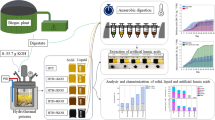Abstract
In this paper, the biological removal of H2S from air had been investigated using a self-made biofilter with efficient bioceramics and a polyhedral hollow ball. The biological removal efficiency of H2S had been analyzed at different experimental conditions, such as inlet H2S concentration, residence time, initial pH value, and reaction temperature etc. The results showed that the initial pH value had a slight effect on H2S removal efficiency from pH 3 to 9. The optimal initial pH value was 5.5, while the H2S removal efficiency was 100%. The H2S removal efficiency increased with increases in the nutrient solution spraying rate. The appropriate temperature was 25°C in the temperature range from 15 to 30°C. The H2S removal efficiency dropped with the increase of air input and inlet H2S concentration. After being isolated and screened, six strains of heterotrophic sulfide oxidizing bacteria and one strain autotrophic sulfide oxidizing bacteria were determined to be involved in the removal of H2S within the biofilter. The reaction kinetics of H2S was in accordance with first order reaction kinetics.
Similar content being viewed by others
References
Liang, H. M. and C. M. Liao (2004) Dynamic transport of livestock generated VOC-odor in a ventilated airspace with mixing heterogeneity. Atmos. Environ. 38: 345–355.
Pan, L. and S. X. Yang (2007) Analysing livestock farm odour using an adaptive neuro-fuzzy approach. Biosyst. Eng. 97: 387–393.
Li, Y. (2002) The environmental problems and counter measures exist in China livestock farming. Shanghai Environ. Sci. 10: 597–599.
Droste, R. L. (1997) Theory and practice of water and wastewater treatment. 1st ed., pp. 98–125. John Wiley & Sons Inc., Wiley, NY, USA.
Gabriel, D., H. J. Cox, and M. A. Deshusses (2004) Conversion of full-scale wet scrubbers to biotrickling filters for H2S control at publicly owned treatment works. J. Environ. Eng. 130: 1110–1117.
Morton, R., A. Lee, C. C. Tang, R. Horvath, and J. Stahl (2005) Production of a two-stage biotrickling filter system for odors and volatile organic compounds removal. Proceedings of 73rd Water Environment Federation Annual Conference and Exposition. October 29–November 2. Washington, DC.
Nishimura, S. and M. Yoda (1997) Removal of H2S from an anaerobic biogas using a bio-scrubber. Water Sci. Technol. 36: 349–356.
Wolstenholme, P. and P. Schafer (2005) Production of odor control bio-scrubbers. A 20 year history of successful applications. Proceedings of 73rd Water Environment Federation Annual Conference and Exposition. October 29–November 2. Washington, DC.
Devinny, J. S., M. A. Deshusses, and T. S. Webster (1998) Biofiltration for Air Pollution Control. 1st ed., pp. 25–30. Lewis Publishers Inc., Boca Raton, FL, USA.
Chen, J., C. Wu, J. Wang, and J. Ma (2006) Performance evaluation of biofilters packed with carbon foam and lava for nitric oxide removal. J. Hazard. Mater. B 137: 172–177.
Chen, Y. X., J. Yin, and K. W. Wang (2005) Long-term operation of biofliters for biological removal of ammonia. Chemosphere 58: 1023–1030.
Seyed, A. S. and E. Siamak (1999) Removal of H2S by the compost biofilter with sludge of leather industry. Resour. Conserv. Recy. 27: 139–144.
Chung, Y. C., C. Huang, and C. P. Tseng (1996) Operation optimization of Thiobacillus thioparus CH11 biofilter for H2S removal. J. Biotechnol. 52: 31–38.
Ren, J., C. Z. Zhang, G. Y. Xu, and W. G. Shi (2007) Experimental Studies on the Elimination of H2S by bio-trickling filter. China Sci. Technol. Information 33:73–74.
Yang, H. L. and J. Y. Xue (2009) The summarize of biofilter remove odour gases. Sci. Technol. Information 36: 261.
Namkung, E., D. V. Lam, M. M. Galera, G. M. Nisoa, S. Son, S. H. Kim, J. H. Song, and W. J. Chung (2005) Hydrogen sulfide removal in biofilters using rock wool and organic media. J. Ind. Eng. Chem. 11: 666–670.
Author information
Authors and Affiliations
Corresponding author
Rights and permissions
About this article
Cite this article
Liang, M.S., Liang, Y. Biological removal of H2S from the livestock manure using a biofilter. Biotechnol Bioproc E 18, 1008–1015 (2013). https://doi.org/10.1007/s12257-013-0025-x
Received:
Revised:
Accepted:
Published:
Issue Date:
DOI: https://doi.org/10.1007/s12257-013-0025-x




